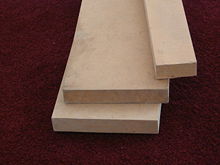Fiberboard
Fibreboard is made from wood, sawmill by-products or residual wood, but also from other wood fiber-containing plants such as flax or rapeseed . What all products have in common is that the wood is broken down into wood fibers , fiber bundles or fiber fragments. The structural cohesion is essentially based on the felting of the wood fibers and their intrinsic binding strength, but adhesives can also be used as binders . The term fiberboard (also wood fiberboard ) describes a product group from the field of wood-based materials . These are to be separated from chipboard .
properties
Fibreboards are produced as single- and multi-layer boards and, like flat-pressed chipboard, behave evenly in all directions in the board plane . They show the same swelling and shrinking behavior in the plane of the plate. Depending on the manufacturing process and density, the following subgroups are distinguished:
- If the wood fiber boards are manufactured using the wet process, a distinction is made between porous, medium-hard and hard fiber boards:
- The wood fiber insulation board (HFD) (also called porous fiber board or Soft Board (SB)) is a board material with a low density (230-350 kg / m³), which is used for heat and sound insulation in construction. Porous fibreboard can also be bound with bitumen .
- The medium hard wood fiber board (MB or HFM) is a board material with a density of 350 to 800 kg / m³.
- The hardboard (HB or HFH) (also hardboard called) having a density above 800 kg / m³ is used for formwork, interior fittings, doors, furniture, packaging. Extra hard fibreboard (HFE) has an even higher density.
- If the wood fiber boards are manufactured in the dry process, a distinction is made between medium and high density fiber boards, and gypsum-bonded fiber boards also belong to this group :
- The medium density fibreboard (MDF) dissolves by their homogeneity, increased strength and improved surface properties by increasing the flat press plates from (P2).
- The high-density fibreboard (HDF) consists of wood fibers soaked with glue and pressed under pressure and heat, which are particularly highly compressed. It is used as a carrier material for high loads with low material thickness (e.g. laminate flooring ).
The plastic-coated hardboard KB or MFB EN 622-2 (HB) for furniture rear walls and drawer bottoms is also widespread.
Manufacturing
The fiber is made from woody plant material. This is done by chopping the raw material, then steaming, boiling and chemical or mechanical opening up to single fibers, fiber bundles or fiber fragments. Modern biotechnology uses enzymes to facilitate digestion and to reduce the use of chemicals - these processes are known as biopulping . The pulping processes largely correspond to those used in the paper and pulp industry. The fiber obtained in this way is partially bleached in order to achieve a higher degree of whiteness for high-quality applications. For this purpose, the lignin, which has a significant part in the dark color of the lignified substance, is z. B. degraded by enzymes - the so-called biobleaching .
Depending on the type of web formation, a distinction is made between the following manufacturing processes:
- In the wet process, the fibers sediment from an aqueous fiber suspension to form the fleece
- In the dry process, the dry fibers are compressed mechanically or pneumatically into a fleece
The resulting mats are then pressed. The cohesion of the fibers in the fleece is due to felting and possibly to added binders. Modern manufacturing processes do without chemical binding agent additives as far as possible, they sometimes use the lignin present in the wood as binding agent.
use
Hard fiberboard is mainly used in vehicle construction and the furniture industry. In construction they are used for concrete cladding, in prefabricated houses and in interior construction, e.g. B. for floor slabs used. Medium-density fibreboard is used as furniture and kitchen fronts, in shops and in loudspeaker construction. Low-density fiber boards are used in particular as wood fiber insulation boards in interior construction.
Economical meaning
Medium-density fibreboard (MDF) in particular is of great economic importance worldwide. Due to its technical properties, it is also one of the fastest growing wood-based products in Europe and Germany . In 2007, more than 55 million m³ of MDF panels were produced worldwide (source FAO). In 2008, however, there was a significant slump in production in Germany and Europe. When it comes to insulating materials made from renewable raw materials , the wood fiber insulation boards are the main products alongside cellulose and short hemp and flax fibers in the form of fleeces.
Individual evidence
- ↑ fibreboard ( memento from August 5th, 2012 in the web archive archive.today ), Gesamtverband deutscher Holzhandel
- ^ Association of the German Wood-Based Panels Industry (VHI). Industry data 2008
literature
- André Wagenführ, Frieder Scholz: Pocket book of wood technology. Specialized book publisher at Carl Hanser Verlag, Leipzig 2008; Pp. 127-259. ISBN 978-3-446-22852-8
- Manfred Dunky, Peter Niemz: Wood-based materials and glues. Springer Verlag, Heidelberg 2002. ISBN 3-540-42980-8 .


